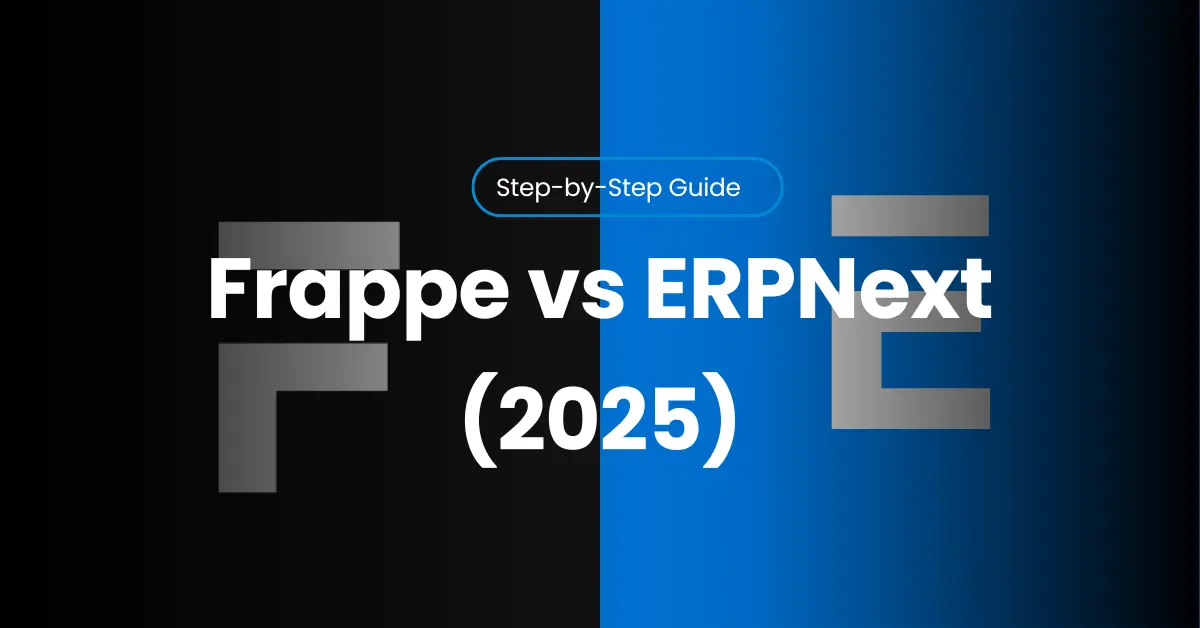Choosing between Frappe and ERPNext can feel like deciding whether to build your own workspace or move into one already designed. Both come from the same open-source ERP ecosystem and are incredibly powerful — but they serve different needs.
In 2025, as businesses move toward smarter automation and cost-effective ERP implementation, this decision matters more than ever. Some teams want the flexibility to shape every workflow from the ground up. Others just need a complete system that runs out of the box.
This guide helps you understand the Frappe vs ERPNext comparison — what each platform offers, where they differ, and which one makes more sense to implement first based on your goals, resources, and growth plans.
Understanding the Basics – Frappe and ERPNext in Simple Terms
Before comparing features or costs, it helps to know what each system actually is. Frappe and ERPNext are tightly connected, but their purposes differ. Think of Frappe as the foundation and ERPNext as the building that stands on it.
The Frappe Framework powers ERPNext, providing the structure, database handling, and web interface. ERPNext, meanwhile, is the ready-to-use ERP solution built on top — offering preconfigured business modules like Accounting, CRM, HR, and Inventory.
What Is the Frappe Framework?
The Frappe Framework is a low-code, open-source web framework that allows developers to build business applications quickly and efficiently. It’s ideal for organizations that want flexibility and control.
Key highlights:
- Built using Python and JavaScript
- Modular structure that supports rapid development
- Ideal for creating custom business workflows
- Backed by a vibrant community and Frappe developer tools
In essence, Frappe gives you the freedom to build ERP-like systems or standalone apps — all within a secure, scalable structure.
What Is ERPNext?
ERPNext is a complete ERP system built on the Frappe Framework. It’s designed for businesses that need an all-in-one solution without building from scratch.
| Feature | Frappe Framework | ERPNext |
| Purpose | Application framework | Full ERP system |
| Ideal Users | Developers & IT teams | Business users & decision-makers |
| Setup | Custom-built | Preconfigured modules |
| Examples | CRM apps, portals, niche systems | Accounting, HR, Inventory, Projects |
ERPNext’s ready-made modules allow companies to streamline operations within days — making it one of the most accessible open-source ERP platforms today.
How They Work Together
Here’s the simplest way to see it: Frappe is the engine, and ERPNext is the car. You can use the engine alone to build something unique, or you can drive the car immediately with proven reliability.
This relationship is what makes the Frappe ecosystem so powerful — businesses can start small with ERPNext and later expand with custom Frappe apps or integrations, all within the same architecture.
Frappe vs ERPNext – Core Differences You Should Know
While both share the same DNA, the Frappe vs ERPNext difference comes down to purpose, customization depth, and scalability. Understanding this helps you avoid over-engineering your solution — or limiting future growth.
Framework vs Application – The Technical Divide
| Criteria | Frappe | ERPNext |
| Type | Development framework | Pre-built ERP application |
| Customization | Extensive (code-level) | Moderate (settings & extensions) |
| Learning Curve | Steep | Easier for non-developers |
| Maintenance | Developer-managed | Managed via hosting or partners |
In short, Frappe gives you control and flexibility, while ERPNext gives you speed and structure. Developers and IT managers often prefer Frappe for full customization, while operations teams value ERPNext’s immediate usability.
Use Case Comparison – Who Should Choose What?
Choose Frappe if:
- You want to build specialized tools or custom workflows.
- Your team includes developers familiar with Frappe bench or Python.
- You plan to integrate multiple systems under one platform.
Choose ERPNext if:
- You need quick ERP implementation with standard modules.
- You want a stable, well-tested ERPNext partner ecosystem.
- You’re focused on faster ROI rather than deep customization.
Maintenance, Cost, and Long-Term Scalability
Frappe gives you complete control but also more responsibility. You’ll handle your own Frappe hosting, updates, and security patches. ERPNext, on the other hand, offers simpler deployment through ERPNext Cloud or managed partners.
In most cases, businesses start with ERPNext for quick value and later extend it using Frappe customization. It’s a balanced way to gain both speed and scalability over time — without heavy upfront complexity.
Which One to Implement First – A Step-by-Step Guide
Now that we’ve covered the fundamentals, let’s walk through a practical implementation guide. This helps you choose the right starting point based on business goals, internal skills, and future plans.
Step 1 – Define Your Business Goals
Before touching any code or setup screen, clarify what you want your ERP solution to achieve.
- Are you aiming for automation or flexibility?
- Do you have in-house developers familiar with the Frappe Framework?
- What’s your expected timeline for ROI?
Your answers here will shape the direction of your ERP setup — not just for today, but for the next five years.
Step 2 – If You Need Quick Deployment, Start with ERPNext
If your business wants a running ERP within weeks, ERPNext is the logical choice. It’s ready out of the box with proven ERP modules for accounting, HR, projects, and CRM.
For small and mid-sized businesses, it’s a cost-effective implementation that delivers fast results and clear visibility across departments.
Step 3 – If You Need Full Flexibility, Begin with Frappe
For developers or IT-driven organizations, starting with Frappe provides maximum freedom. You can design every process, build custom interfaces, and integrate unique data sources.
It’s ideal for companies in niche industries or with complex, non-standard operations where traditional ERP systems don’t fit neatly.
Step 4 – When a Hybrid Approach Works Best
Many businesses start with ERPNext for rapid deployment, then expand through Frappe apps as needs grow.
For example, a manufacturing firm might use ERPNext for finance and inventory, then build a Frappe-based production scheduler. This hybrid model balances structure with scalability — and is one we’ve successfully implemented at Infintrix Technologies for clients scaling globally.
Implementation Insights for 2025 – What’s Changing This Year
The Frappe and ERPNext ecosystem continues to evolve rapidly, with new updates aimed at improving performance, security, and usability. For businesses planning ERP implementation in USA in 2025, staying aware of these shifts can make deployment smoother and more strategic.
This year, the focus is on cloud flexibility, tighter integrations, and better scalability — making both systems more appealing for businesses that value real-time visibility and data-driven decisions.
Key Updates in Frappe and ERPNext (2025)
Here are some of the most impactful upgrades seen this year:
- Modernized dashboards with improved analytics and filters
- Enhanced Frappe developer tools for faster app building
- Expanded Frappe integration with third-party APIs and IoT systems
- Improved user permissions and security in ERPNext Cloud environments
For IT managers, these changes mean less manual configuration and a smoother Frappe cloud deployment process overall.
Hosting Choices – Self, Cloud, or Managed?
Choosing the right hosting model is critical to stability and cost control.
| Hosting Type | Control | Maintenance | Best For |
| Self-hosted | High | Manual updates | Experienced IT teams |
| Frappe Cloud | Medium | Partially managed | Growing SMEs |
| ERPNext Cloud | Low | Fully managed | Businesses seeking simplicity |
At Infintrix Technologies, we’ve seen managed Frappe ERPNext hosting significantly reduce downtime and technical overhead for clients. For most SMBs, managed cloud solutions provide the right balance between control and convenience.
Common Implementation Pitfalls (and How to Avoid Them)
Even the best ERP projects face challenges early on. The key is anticipating them.
Typical pitfalls include:
- Incomplete data migration from legacy systems
- Over-customization before process alignment
- Poor change management and user adoption
- Neglecting scalability or backup planning
At Infintrix Technologies, we’ve found that structured onboarding and regular user training minimize these issues, ensuring smoother go-live experiences and better long-term adoption.
Real-World Use Cases – How Businesses Benefit from Each Approach
Theory aside, real results often come from matching the right tool to the right situation. Businesses using Frappe or ERPNext in 2025 are finding creative ways to achieve both efficiency and agility.
Growing Startups Winning with ERPNext
Startups often don’t have the time or technical bandwidth to build from scratch. ERPNext helps them automate finance, HR, and CRM operations quickly — often within weeks.
For instance, a retail startup we worked with implemented ERPNext to replace spreadsheets and manual invoicing. Within a month, they gained real-time visibility into sales and stock, cutting reconciliation time by over 60%.
Developer Teams Innovating with Frappe
For developer-led teams, Frappe is a creative playground. It allows them to build Frappe-based ERP extensions, portals, or niche business tools that integrate seamlessly with existing workflows.
For example, a logistics firm used Frappe apps to design a custom shipment tracking portal integrated with ERPNext. This gave them precise control without reinventing core ERP features.
Combining Both for Scalable Growth
Some of the most successful companies we’ve supported at Infintrix Technologies use a hybrid Frappe + ERPNext model. They deploy ERPNext as the operational backbone, then extend it using Frappe customization for industry-specific needs — from manufacturing dashboards to customer self-service portals.
This approach ensures scalability without disrupting the core ERP system — a practical strategy for fast-growing enterprises.
Expert Take – Our Recommendation for 2025
Based on years of hands-on ERP projects across industries, our view is simple: the right choice depends on your business maturity and resources.
If you’re starting fresh and want immediate value, ERPNext provides the stability and usability you need. If you have development expertise and require deeper control, Frappe is the more flexible option.
At Infintrix Technologies, we recommend aligning your ERP decision with your long-term business strategy — not just short-term convenience. The best implementations are the ones that grow with you.
Conclusion – Making the Right Decision for Your Business
Both Frappe and ERPNext are exceptional tools within the open-source ERP ecosystem. The key is not which is “better,” but which aligns with your company’s structure, expertise, and growth path.
Whether you choose to build from the Frappe Framework or start with the ERPNext system, success comes down to clarity, planning, and ongoing support.
At Infintrix Technologies, we’ve helped businesses take both paths — some launching ERPNext in days, others crafting custom Frappe solutions for highly specific needs. With the right guidance, your ERP implementation can deliver automation, scalability, and real ROI.
FAQs – Common Questions About Frappe vs ERPNext
Is ERPNext built on the Frappe Framework?
Yes. The Frappe Framework explained: it’s the base architecture that powers ERPNext, handling backend logic, database management, and web UI.
Can I use Frappe without ERPNext?
Absolutely. Many developers build standalone business applications using Frappe without deploying ERPNext.
Which is better for startups in 2025?
ERPNext is ideal for quick, out-of-the-box deployment, while Frappe suits teams wanting full flexibility.
Can I start with ERPNext and later customize using Frappe?
Yes — this hybrid path is common. Teams like Infintrix Technologies often guide clients through this transition as their needs evolve.
What skills are needed to manage Frappe or ERPNext?
Basic understanding of Python, web hosting, and ERP workflows helps. Otherwise, partnering with an experienced ERPNext partner ensures smooth setup and maintenance.

